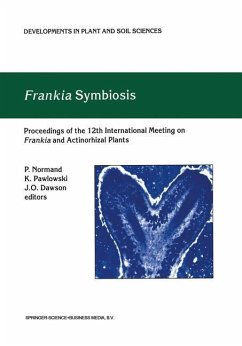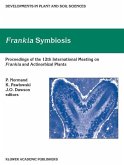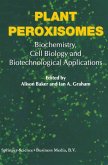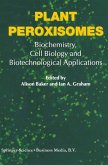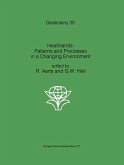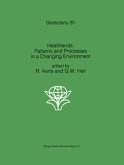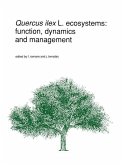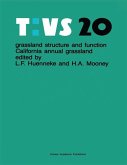Frankia Symbiosis
Herausgegeben:Normand, P.; Pawlowski, K.; Dawson, J. O.
Frankia Symbiosis
Herausgegeben:Normand, P.; Pawlowski, K.; Dawson, J. O.
- Broschiertes Buch
- Merkliste
- Auf die Merkliste
- Bewerten Bewerten
- Teilen
- Produkt teilen
- Produkterinnerung
- Produkterinnerung
The 12 th meeting on Frankia and Actinorhizal Plants that took place in Carry-le-Rouet, France in June 2001 was the opportunity for scientists to communicate about latest developments on this symbiosis that concerns a wide range of dicotyledonous plants, initiates ecological successions and is used in a number of countries to protect crops from winds or improve soil status. Selected papers on plant ecology, Frankia's genetics or physiology, and host plants' genetics or physiology are published in this special Plant & Soil issue.
Andere Kunden interessierten sich auch für
![Frankia Symbiosis Frankia Symbiosis]() P. Normand / K. Pawlowski / J.O. Dawson (Hgg.)Frankia Symbiosis153,99 €
P. Normand / K. Pawlowski / J.O. Dawson (Hgg.)Frankia Symbiosis153,99 €![Plant Peroxisomes Plant Peroxisomes]() A. Baker / I.A. Graham (eds.)Plant Peroxisomes153,99 €
A. Baker / I.A. Graham (eds.)Plant Peroxisomes153,99 €![Plant Peroxisomes Plant Peroxisomes]() Plant Peroxisomes149,99 €
Plant Peroxisomes149,99 €![Heathlands Heathlands]() Heathlands115,99 €
Heathlands115,99 €![Heathlands Heathlands]() R. Aerts / G.W. Heil (eds.)Heathlands115,99 €
R. Aerts / G.W. Heil (eds.)Heathlands115,99 €![Quercus ilex L. ecosystems: function, dynamics and management Quercus ilex L. ecosystems: function, dynamics and management]() Quercus ilex L. ecosystems: function, dynamics and management229,99 €
Quercus ilex L. ecosystems: function, dynamics and management229,99 €![Grassland structure and function Grassland structure and function]() HuennekeGrassland structure and function115,99 €
HuennekeGrassland structure and function115,99 €-
-
-
The 12th meeting on Frankia and Actinorhizal Plants that took place in Carry-le-Rouet, France in June 2001 was the opportunity for scientists to communicate about latest developments on this symbiosis that concerns a wide range of dicotyledonous plants, initiates ecological successions and is used in a number of countries to protect crops from winds or improve soil status. Selected papers on plant ecology, Frankia's genetics or physiology, and host plants' genetics or physiology are published in this special Plant & Soil issue.
Produktdetails
- Produktdetails
- Developments in Plant and Soil Sciences 100
- Verlag: Springer / Springer Netherlands
- Artikelnr. des Verlages: 978-90-481-6380-9
- Softcover reprint of hardcover 1st edition 2003
- Seitenzahl: 256
- Erscheinungstermin: 18. Dezember 2010
- Englisch
- Abmessung: 254mm x 178mm x 16mm
- Gewicht: 489g
- ISBN-13: 9789048163809
- ISBN-10: 9048163803
- Artikelnr.: 32018691
- Herstellerkennzeichnung
- Springer-Verlag GmbH
- Tiergartenstr. 17
- 69121 Heidelberg
- ProductSafety@springernature.com
- Developments in Plant and Soil Sciences 100
- Verlag: Springer / Springer Netherlands
- Artikelnr. des Verlages: 978-90-481-6380-9
- Softcover reprint of hardcover 1st edition 2003
- Seitenzahl: 256
- Erscheinungstermin: 18. Dezember 2010
- Englisch
- Abmessung: 254mm x 178mm x 16mm
- Gewicht: 489g
- ISBN-13: 9789048163809
- ISBN-10: 9048163803
- Artikelnr.: 32018691
- Herstellerkennzeichnung
- Springer-Verlag GmbH
- Tiergartenstr. 17
- 69121 Heidelberg
- ProductSafety@springernature.com
2. Frankia inoculation, soil biota, and host tissue amendment influence Casuarina nodulation capacity of a tropical soil.- 3. An assessment of soil enrichment by actinorhizal N2 fixation using ?15N values in a chronosequence of deglaciation at Glacier Bay, Alaska.- 4. Effects of land irrigation with partially-treated wastewater on Frankia survival and infectivity.- 5. The production and utilisation of monoclonal antibodies for identification of a Frankia strain utilised as inoculum for Casuarina equisetifolia.- 6. The effects of fire on soil nitrogen associated with patches of the actinorhizal shrub Ceanothus cordulatus.- 7. Alder and lupine enhance nitrogen cycling in a degraded forest soil in Northern Sweden.- 8. Germination and physiological properties of Frankia spores.- 9. Improving dispersed growth of Frankia using Carbopol.- 10. Identification and expression studies of a catalase and a bifunctional catalase-peroxidase in Frankia strain R43.- 11. Effect of electroporation conditions on cell viability of Frankia EuI1c.- 12. Molecular cloning and characterization of adr and ivd genes from Frankia EuIK1 strain.- 13. Cloning, characterisation and phylogenetic analysis of the sigA?70 factor gene sequence from the actinomycete Frankia.- 14. An insertion sequence unique to Frankia strain ArI5.- 15. Genomic fingerprinting of Frankia strains by PCR-based techniques. Assessment of a primer based on the sequence of 16S rRNA gene of Escherichia coli.- 16. Progress on the genetics of the N2-fixing actinorhizal symbiont Frankia.- 17. Ammonium assimilation in root nodules of actinorhizal Discaria trinervis. Regulation of enzyme activities and protein levels by the availability of macronutrients (N, P and C).- 18. The regulation of nodulation, nitrogen fixation and ammoniumassimilation under a carbohydrate shortage stress in the Discaria trinervis-Frankia symbiosis.- 19. Seasonal flooding regimes influence survival, nitrogen fixation, and the partitioning of nitrogen and biomass in Alnus incana ssp. rugosa.- 20. Tripartite associations in an alder: effects of Frankia and Alpova diplophloeus on the growth, nitrogen fixation and mineral acquisition of Alnus tenuifolia.- 21. Nodulation potential of soils from red alder stands covering a wide age range.- 22. A possible role for phenyl acetic acid (PAA) on Alnus glutinosa nodulation by Frankia.- 23. Molecular phylogeny of Alnus (Betulaceae), inferred from nuclear ribosomal DNA ITS sequences.- 24. Evolutionary implications of nucleotide sequence relatedness between Alnus nepalensis and Alnus glutinosa and also between corresponding Frankia microsymbionts.- 25. Choosing a reporter for gene expression studies in transgenic actinorhizal plants of the Casuarinaceae family.- 26. Expression pattern of ara12*, an Arabidopsis homologue of the nodule-specific actinorhizal subtilases cg12/ag12.
2. Frankia inoculation, soil biota, and host tissue amendment influence Casuarina nodulation capacity of a tropical soil.- 3. An assessment of soil enrichment by actinorhizal N2 fixation using ?15N values in a chronosequence of deglaciation at Glacier Bay, Alaska.- 4. Effects of land irrigation with partially-treated wastewater on Frankia survival and infectivity.- 5. The production and utilisation of monoclonal antibodies for identification of a Frankia strain utilised as inoculum for Casuarina equisetifolia.- 6. The effects of fire on soil nitrogen associated with patches of the actinorhizal shrub Ceanothus cordulatus.- 7. Alder and lupine enhance nitrogen cycling in a degraded forest soil in Northern Sweden.- 8. Germination and physiological properties of Frankia spores.- 9. Improving dispersed growth of Frankia using Carbopol.- 10. Identification and expression studies of a catalase and a bifunctional catalase-peroxidase in Frankia strain R43.- 11. Effect of electroporation conditions on cell viability of Frankia EuI1c.- 12. Molecular cloning and characterization of adr and ivd genes from Frankia EuIK1 strain.- 13. Cloning, characterisation and phylogenetic analysis of the sigA?70 factor gene sequence from the actinomycete Frankia.- 14. An insertion sequence unique to Frankia strain ArI5.- 15. Genomic fingerprinting of Frankia strains by PCR-based techniques. Assessment of a primer based on the sequence of 16S rRNA gene of Escherichia coli.- 16. Progress on the genetics of the N2-fixing actinorhizal symbiont Frankia.- 17. Ammonium assimilation in root nodules of actinorhizal Discaria trinervis. Regulation of enzyme activities and protein levels by the availability of macronutrients (N, P and C).- 18. The regulation of nodulation, nitrogen fixation and ammoniumassimilation under a carbohydrate shortage stress in the Discaria trinervis-Frankia symbiosis.- 19. Seasonal flooding regimes influence survival, nitrogen fixation, and the partitioning of nitrogen and biomass in Alnus incana ssp. rugosa.- 20. Tripartite associations in an alder: effects of Frankia and Alpova diplophloeus on the growth, nitrogen fixation and mineral acquisition of Alnus tenuifolia.- 21. Nodulation potential of soils from red alder stands covering a wide age range.- 22. A possible role for phenyl acetic acid (PAA) on Alnus glutinosa nodulation by Frankia.- 23. Molecular phylogeny of Alnus (Betulaceae), inferred from nuclear ribosomal DNA ITS sequences.- 24. Evolutionary implications of nucleotide sequence relatedness between Alnus nepalensis and Alnus glutinosa and also between corresponding Frankia microsymbionts.- 25. Choosing a reporter for gene expression studies in transgenic actinorhizal plants of the Casuarinaceae family.- 26. Expression pattern of ara12*, an Arabidopsis homologue of the nodule-specific actinorhizal subtilases cg12/ag12.

